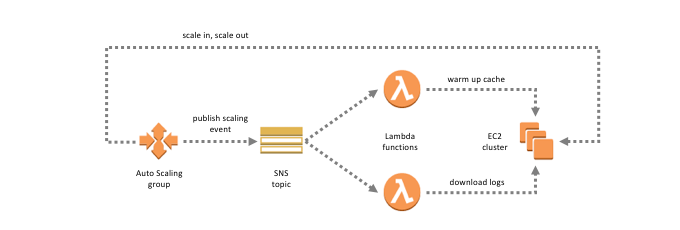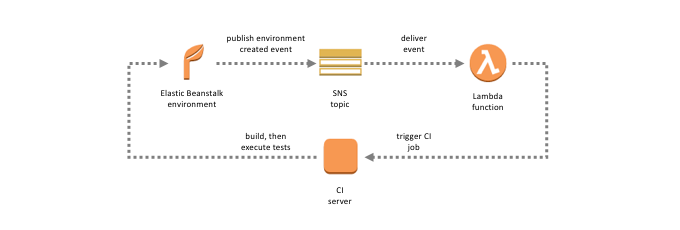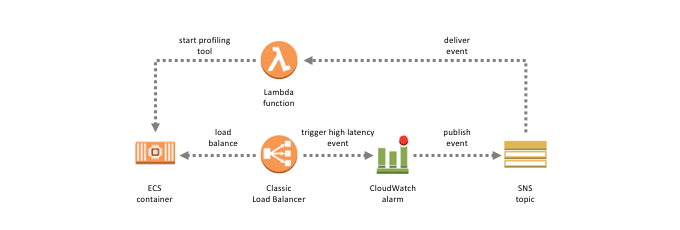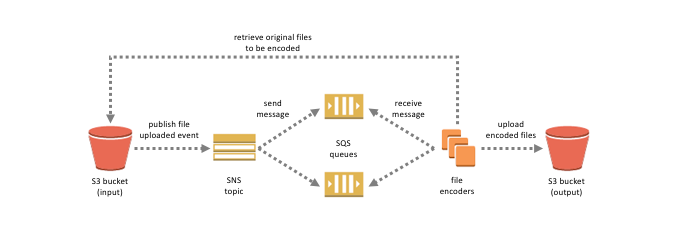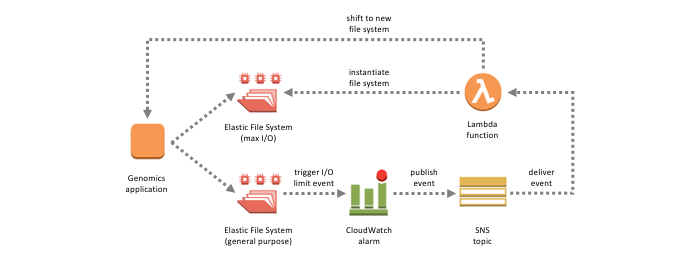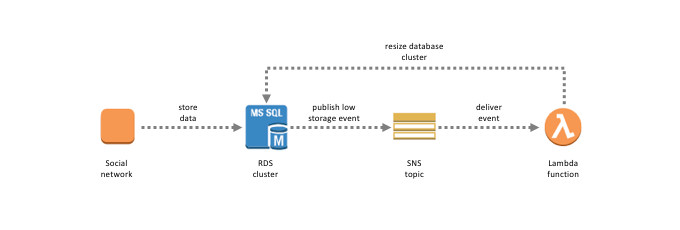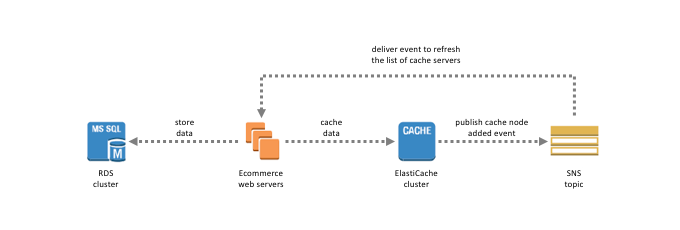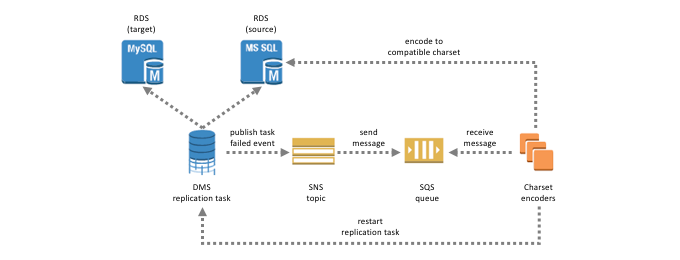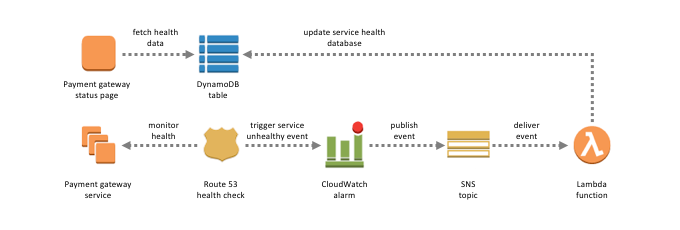AWS Compute Blog
Event-Driven Computing with Amazon SNS and AWS Compute, Storage, Database, and Networking Services
Contributed by Otavio Ferreira, Manager, Software Development, AWS Messaging
Like other developers around the world, you may be tackling increasingly complex business problems. A key success factor, in that case, is the ability to break down a large project scope into smaller, more manageable components. A service-oriented architecture guides you toward designing systems as a collection of loosely coupled, independently scaled, and highly reusable services. Microservices take this even further. To improve performance and scalability, they promote fine-grained interfaces and lightweight protocols.
However, the communication among isolated microservices can be challenging. Services are often deployed onto independent servers and don’t share any compute or storage resources. Also, you should avoid hard dependencies among microservices, to preserve maintainability and reusability.
If you apply the pub/sub design pattern, you can effortlessly decouple and independently scale out your microservices and serverless architectures. A pub/sub messaging service, such as Amazon SNS, promotes event-driven computing that statically decouples event publishers from subscribers, while dynamically allowing for the exchange of messages between them. An event-driven architecture also introduces the responsiveness needed to deal with complex problems, which are often unpredictable and asynchronous.
What is event-driven computing?
Given the context of microservices, event-driven computing is a model in which subscriber services automatically perform work in response to events triggered by publisher services. This paradigm can be applied to automate workflows while decoupling the services that collectively and independently work to fulfil these workflows. Amazon SNS is an event-driven computing hub, in the AWS Cloud, that has native integration with several AWS publisher and subscriber services.
Which AWS services publish events to SNS natively?
Several AWS services have been integrated as SNS publishers and, therefore, can natively trigger event-driven computing for a variety of use cases. In this post, I specifically cover AWS compute, storage, database, and networking services, as depicted below.
Compute services
- Auto Scaling: Helps you ensure that you have the correct number of Amazon EC2 instances available to handle the load for your application. You can configure Auto Scaling lifecycle hooks to trigger events, as Auto Scaling resizes your EC2 cluster.As an example, you may want to warm up the local cache store on newly launched EC2 instances, and also download log files from other EC2 instances that are about to be terminated. To make this happen, set an SNS topic as your Auto Scaling group’s notification target, then subscribe two Lambda functions to this SNS topic. The first function is responsible for handling scale-out events (to warm up cache upon provisioning), whereas the second is in charge of handling scale-in events (to download logs upon termination).
- AWS Elastic Beanstalk: An easy-to-use service for deploying and scaling web applications and web services developed in a number of programming languages. You can configure event notifications for your Elastic Beanstalk environment so that notable events can be automatically published to an SNS topic, then pushed to topic subscribers.As an example, you may use this event-driven architecture to coordinate your continuous integration pipeline (such as Jenkins CI). That way, whenever an environment is created, Elastic Beanstalk publishes this event to an SNS topic, which triggers a subscribing Lambda function, which then kicks off a CI job against your newly created Elastic Beanstalk environment.
- Elastic Load Balancing: Automatically distributes incoming application traffic across Amazon EC2 instances, containers, or other resources identified by IP addresses.You can configure CloudWatch alarms on Elastic Load Balancing metrics, to automate the handling of events derived from Classic Load Balancers. As an example, you may leverage this event-driven design to automate latency profiling in an Amazon ECS cluster behind a Classic Load Balancer. In this example, whenever your ECS cluster breaches your load balancer latency threshold, an event is posted by CloudWatch to an SNS topic, which then triggers a subscribing Lambda function. This function runs a task on your ECS cluster to trigger a latency profiling tool, hosted on the cluster itself. This can enhance your latency troubleshooting exercise by making it timely.
Storage services
- Amazon S3: Object storage built to store and retrieve any amount of data.You can enable S3 event notifications, and automatically get them posted to SNS topics, to automate a variety of workflows. For instance, imagine that you have an S3 bucket to store incoming resumes from candidates, and a fleet of EC2 instances to encode these resumes from their original format (such as Word or text) into a portable format (such as PDF).In this example, whenever new files are uploaded to your input bucket, S3 publishes these events to an SNS topic, which in turn pushes these messages into subscribing SQS queues. Then, encoding workers running on EC2 instances poll these messages from the SQS queues; retrieve the original files from the input S3 bucket; encode them into PDF; and finally store them in an output S3 bucket.
- Configuring Amazon S3 Event Notifications
- Configuring Amazon S3 Buckets for Amazon SNS Notifications (Walkthrough)
- Messaging Fan-out Pattern for Serverless Architectures Using Amazon SNS (Multimedia Encoding Example)
- Amazon EFS: Provides simple and scalable file storage, for use with Amazon EC2 instances, in the AWS Cloud.You can configure CloudWatch alarms on EFS metrics, to automate the management of your EFS systems. For example, consider a highly parallelized genomics analysis application that runs against an EFS system. By default, this file system is instantiated on the “General Purpose” performance mode. Although this performance mode allows for lower latency, it might eventually impose a scaling bottleneck. Therefore, you may leverage an event-driven design to handle it automatically.Basically, as soon as the EFS metric “Percent I/O Limit” breaches 95%, CloudWatch could post this event to an SNS topic, which in turn would push this message into a subscribing Lambda function. This function automatically creates a new file system, this time on the “Max I/O” performance mode, then switches the genomics analysis application to this new file system. As a result, your application starts experiencing higher I/O throughput rates.
- Amazon Glacier: A secure, durable, and low-cost cloud storage service for data archiving and long-term backup.You can set a notification configuration on an Amazon Glacier vault so that when a job completes, a message is published to an SNS topic. Retrieving an archive from Amazon Glacier is a two-step asynchronous operation, in which you first initiate a job, and then download the output after the job completes. Therefore, SNS helps you eliminate polling your Amazon Glacier vault to check whether your job has been completed, or not. As usual, you may subscribe SQS queues, Lambda functions, and HTTP endpoints to your SNS topic, to be notified when your Amazon Glacier job is done.
- AWS Snowball: A petabyte-scale data transport solution that uses secure appliances to transfer large amounts of data.You can leverage Snowball notifications to automate workflows related to importing data into and exporting data from AWS. More specifically, whenever your Snowball job status changes, Snowball can publish this event to an SNS topic, which in turn can broadcast the event to all its subscribers.As an example, imagine a Geographic Information System (GIS) that distributes high-resolution satellite images to users via Web browser. In this example, the GIS vendor could capture up to 80 TB of satellite images; create a Snowball job to import these files from an on-premises system to an S3 bucket; and provide an SNS topic ARN to be notified upon job status changes in Snowball. After Snowball changes the job status from “Importing” to “Completed”, Snowball publishes this event to the specified SNS topic, which delivers this message to a subscribing Lambda function, which finally creates a CloudFront web distribution for the target S3 bucket, to serve the images to end users.
- Snowball Notifications with Amazon SNS (AWS Snowball User Guide)
- Snowball Notifications with Amazon SNS (AWS Snowball API Reference)
- Getting Started with CloudFront
Database services
- Amazon RDS: Makes it easy to set up, operate, and scale a relational database in the cloud.RDS leverages SNS to broadcast notifications when RDS events occur. As usual, these notifications can be delivered via any protocol supported by SNS, including SQS queues, Lambda functions, and HTTP endpoints.As an example, imagine that you own a social network website that has experienced organic growth, and needs to scale its compute and database resources on demand. In this case, you could provide an SNS topic to listen to RDS DB instance events. When the “Low Storage” event is published to the topic, SNS pushes this event to a subscribing Lambda function, which in turn leverages the RDS API to increase the storage capacity allocated to your DB instance. The provisioning itself takes place within the specified DB maintenance window.
- Amazon ElastiCache: A web service that makes it easy to deploy, operate, and scale an in-memory data store or cache in the cloud.ElastiCache can publish messages using Amazon SNS when significant events happen on your cache cluster. This feature can be used to refresh the list of servers on client machines connected to individual cache node endpoints of a cache cluster. For instance, an ecommerce website fetches product details from a cache cluster, with the goal of offloading a relational database and speeding up page load times. Ideally, you want to make sure that each web server always has an updated list of cache servers to which to connect.To automate this node discovery process, you can get your ElastiCache cluster to publish events to an SNS topic. Thus, when ElastiCache event “AddCacheNodeComplete” is published, your topic then pushes this event to all subscribing HTTP endpoints that serve your ecommerce website, so that these HTTP servers can update their list of cache nodes.
- Amazon Redshift: A fully managed data warehouse that makes it simple to analyze data using standard SQL and BI (Business Intelligence) tools.Amazon Redshift uses SNS to broadcast relevant events so that data warehouse workflows can be automated. As an example, imagine a news website that sends clickstream data to a Kinesis Firehose stream, which then loads the data into Amazon Redshift, so that popular news and reading preferences might be surfaced on a BI tool. At some point though, this Amazon Redshift cluster might need to be resized, and the cluster enters a ready-only mode. Hence, this Amazon Redshift event is published to an SNS topic, which delivers this event to a subscribing Lambda function, which finally deletes the corresponding Kinesis Firehose delivery stream, so that clickstream data uploads can be put on hold.At a later point, after Amazon Redshift publishes the event that the maintenance window has been closed, SNS notifies a subscribing Lambda function accordingly, so that this function can re-create the Kinesis Firehose delivery stream, and resume clickstream data uploads to Amazon Redshift.
- AWS DMS: Helps you migrate databases to AWS quickly and securely. The source database remains fully operational during the migration, minimizing downtime to applications that rely on the database.DMS also uses SNS to provide notifications when DMS events occur, which can automate database migration workflows. As an example, you might create data replication tasks to migrate an on-premises MS SQL database, composed of multiple tables, to MySQL. Thus, if replication tasks fail due to incompatible data encoding in the source tables, these events can be published to an SNS topic, which can push these messages into a subscribing SQS queue. Then, encoders running on EC2 can poll these messages from the SQS queue, encode the source tables into a compatible character set, and restart the corresponding replication tasks in DMS. This is an event-driven approach to a self-healing database migration process.
Networking services
- Amazon Route 53: A highly available and scalable cloud-based DNS (Domain Name System). Route 53 health checks monitor the health and performance of your web applications, web servers, and other resources.You can set CloudWatch alarms and get automated Amazon SNS notifications when the status of your Route 53 health check changes. As an example, imagine an online payment gateway that reports the health of its platform to merchants worldwide, via a status page. This page is hosted on EC2 and fetches platform health data from DynamoDB. In this case, you could configure a CloudWatch alarm for your Route 53 health check, so that when the alarm threshold is breached, and the payment gateway is no longer considered healthy, then CloudWatch publishes this event to an SNS topic, which pushes this message to a subscribing Lambda function, which finally updates the DynamoDB table that populates the status page. This event-driven approach avoids any kind of manual update to the status page visited by merchants.
- AWS Direct Connect (AWS DX): Makes it easy to establish a dedicated network connection from your premises to AWS, which can reduce your network costs, increase bandwidth throughput, and provide a more consistent network experience than Internet-based connections.You can monitor physical DX connections using CloudWatch alarms, and send SNS messages when alarms change their status. As an example, when a DX connection state shifts to 0 (zero), indicating that the connection is down, this event can be published to an SNS topic, which can fan out this message to impacted servers through HTTP endpoints, so that they might reroute their traffic through a different connection instead. This is an event-driven approach to connectivity resilience.
 More event-driven computing on AWS
More event-driven computing on AWS
In addition to SNS, event-driven computing is also addressed by Amazon CloudWatch Events, which delivers a near real-time stream of system events that describe changes in AWS resources. With CloudWatch Events, you can route each event type to one or more targets, including:
- SNS topics
- Amazon SQS queues
- Amazon EC2 instances
- Amazon ECS tasks
- Amazon Kinesis Streams
- Amazon Kinesis Firehose delivery streams
- AWS Lambda functions
- AWS Step Functions state machines
- AWS CodePipeline pipelines
Many AWS services publish events to CloudWatch. As an example, you can get CloudWatch Events to capture events on your ETL (Extract, Transform, Load) jobs running on AWS Glue and push failed ones to an SQS queue, so that you can retry them later.
Conclusion
Amazon SNS is a pub/sub messaging service that can be used as an event-driven computing hub to AWS customers worldwide. By capturing events natively triggered by AWS services, such as EC2, S3 and RDS, you can automate and optimize all kinds of workflows, namely scaling, testing, encoding, profiling, broadcasting, discovery, failover, and much more. Business use cases presented in this post ranged from recruiting websites, to scientific research, geographic systems, social networks, retail websites, and news portals.
Start now by visiting Amazon SNS in the AWS Management Console, or by trying the AWS 10-Minute Tutorial, Send Fan-out Event Notifications with Amazon SNS and Amazon SQS.

